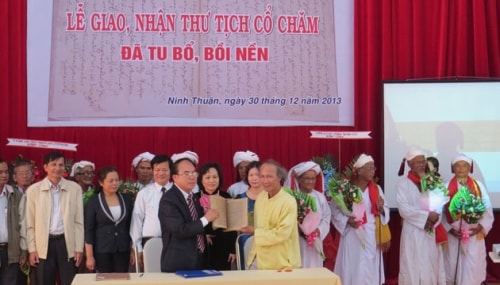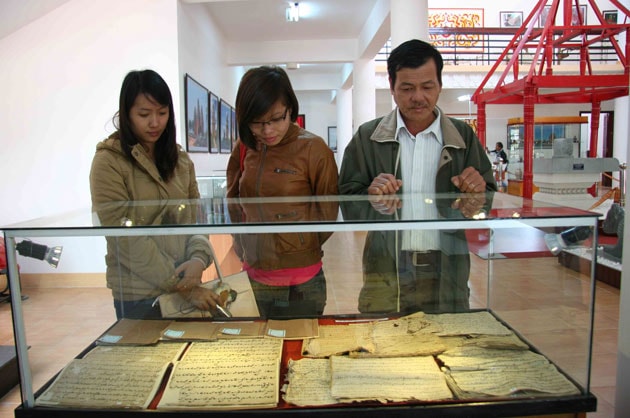Ancient Cham texts will no longer be damaged.
On December 30, in Phan Rang-Thap Cham City (Ninh Thuan), National Archives Center II held a ceremony to hand over 62 ancient Cham books and 281 rolls of film to copy ancient books to the Center for Cham Cultural Research in Ninh Thuan province.
 |
| Handover ceremony of ancient Cham documents |
Records in ancient Cham books contain many fields, such as: rituals, astronomy, medicine, history, folk tales, myths, legends, stories, folk songs, proverbs... Currently, many ancient books are still preserved in the Cham community in Vietnam.
According to scientists, Cham script is divided into three periods: ancient, medieval and modern. Ancient script is the type of script that is usually engraved on stone steles such as Vo Canh stone stele in Khanh Hoa province; medieval script is written on palm leaves or on paper that very few Cham people can read today. The remaining modern script is called Akhar thrah - a common script, commonly used by Cham people to record documents from the 17th century until now. This type of script is considered an ancient script commonly used by Cham people.
Director of the Ninh Thuan Cham Cultural Research Center, Mr. Dang Nang Tho, said: "The Cham people's writing originates from Sanskrit - an ancient writing, and has developed to the modern writing that is commonly used in all classes of the Cham community."
Over the past decades, the Ninh Thuan Cham Cultural Research Center has collected 62 ancient Cham books with 3,566 pages on materials such as: Do paper, palm leaves, fabric... along with 281 rolls of film to photocopy ancient books with many contents about culture, religion, customs and practices of the Cham people... However, many valuable documents have been and are being destroyed by the environment, climate, insects due to preservation methods that do not meet technical requirements, so many pages of ancient books are damaged, many pages are punctured, torn and cannot be looked up information.
In May 2013, the National Archives Center II helped the Ninh Thuan Cham Cultural Research Center to repair, restore, backfill and digitize all the collected ancient documents. Master Nguyen Thi Thuy Binh, Director of the Center for Science and Technology of Archives - Head of the project "Collecting rare documents of Vietnam and about Vietnam" said that when restoring ancient Cham documents, the team of experts of the National Archives Center II encountered a series of difficulties because most of the document pages were in a brittle, crumbly, sticky state and easily torn. Many pages were damaged by termites and rodents. Through research, the experts applied cleaning and disinfection methods to remove spores of molds and insects that are harmful to the documents; peeled and flattened each page of the document with specialized equipment; backfilled the entire base with a special type of glue, backfilled one side with Vietnamese do paper and two sides with Japanese do paper. After being mounted, the documents are flattened, the edges of each sheet are trimmed, then rearranged into books, numbered on each page, digitized according to archival industry standards, and bound back in their original state.
After digitization, the documents are placed in the search software, when needed, they can be read on the computer, without having to read the original.
Dr. Vu Thi Minh Huong, Director of the State Records and Archives Department, said: "With advanced technology, the unit has restored, restored, filled the foundation and digitized the entire number of ancient documents up to 12,334 pages, not only restoring the written content but also helping to preserve the ancient documents well to avoid environmental damage for hundreds of years."
 |
| Visitors to ancient Cham books |
On this occasion, from December 30 to February 28, 2014, Ninh Thuan Cham Cultural Research Center organizes an exhibition of ancient Cham documents to serve the sightseeing and research needs of tourists and people.
According to NDDT






